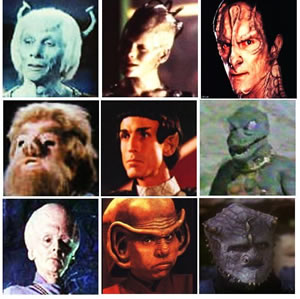
Aliens from Star Trek were all humanoid
in nature. Hardly alien at all…
A frequent criticism of the popular television series Star Trek: The Next Generation centered around the unremarkable physical appearance of its various alien species. In nearly every episode, the crew of the starship Enterprise would encounter a “new” civilization– a society of life-forms that had supposedly developed in complete isolation from other worlds. Amazingly, the overwhelming majority of these aliens barely differed in appearance from humans, typically distinguished by a small wrinkle on their forehead or nose. This absurdity prompted a critic on Trek’s own website to dub them “Forehead Aliens of the Week.” Even more preposterous than their physical similarity to humans, however, was the utter lack of divergent philosophies and sociopolitical ideals exhibited by these “aliens.” Most displayed emotions and value systems not just identical to humans, but to 21st century Western humans. The series’ portrayals do not begin to approach the magnitude of social and political differences that exist between different human cultures on present-day Earth and throughout human history, let alone the unimaginable uniqueness an alien species would unquestionably possess.
Such blatant ethnocentrism seems remarkably obtuse for a series whose audience was generally well-informed (albeit slightly geeky). But just as the original Star Trek series was guilty of reflecting the racial and gender biases of the 1960’s, so too did the contemporary series mirror a fundamental ethnocentrism inherent in popular culture today. Even modern social scientists tend to subscribe to principles that undervalue cultural diversity. Scholars obviously respect cultural and social differences, and therefore recognize the need to preserve cultural diversity, but the prevailing social scientific ideology maintains that a certain psychic unity binds each human mind. While culture is no longer always considered an extraneous variable, it is still treated as an external influence. The assumption is that all humans are the same “deep down,” and that cultural divergences are secondary or superficial. This can largely be attributed to the Platonic and Judeo-Christian dualistic foundation upon which Western academia still rests. These dubious principles reverberate throughout society, and are manifest in our negligent foreign policy. A society whose academic underpinning is psychological universalism is predisposed to undervaluing cultural diversity. If a people are the same everywhere, then the significance of displacing “primitive” and “superstitious” belief systems diminishes.
This is clearly the case, as today’s policymakers exhibit a blithe disregard for psychodiversity. Authorities in both developed and developing countries are failing to curb the destruction of the unique cultures endemic to their regions. The majority of the human population can now be categorized as belonging to the same essential culture. Hunter-gatherer tribes presently account for less than one percent of the human population. Even the lines between the proverbial East and West are being blurred, as ancient empires like Japan openly advance their efforts to “Westernize.” Little is being done to impede these changes. The rampant spread of postindustrial materialistic culture is deemed “progress;” the cultures it supplants, obsolete. Indeed, the aforementioned ethnocentric worldview may soon become reality.
He characterizes the existence of diverse sociocultural environments as multiple objective realities.
University of Chicago scholar Richard Shweder is at the forefront of a resurgent discipline that challenges the traditional Platonism underlying modern psychology. Shweder asserts that culture, environmental factors, and belief systems are inextricable from an accurate conception of individual mental processes. He characterizes the existence of diverse sociocultural environments as multiple objective realities. He refers to them as “intentional worlds,” stating that they are “real, factual, and forceful, but only so long as…mental representations are directed at [them].”
The notion that a pure essence of humanity is present at the core of each mind is an anachronism. Shweder’s view, although against convention, is much more grounded in reality. By his reasoning, futurists who ask whether humanity will endure may need to revise their operative question, instead asking which humanity will endure.
The answer will likely depend on the outcome of an assault on psychodiversity that dates back to the beginning of civilization, when regional tribes first began to coalesce into ordered city-states. The assault has continued without interruption, highlighted by Roman and Chinese imperialism, European colonialism, and economic globalization. Now, carried on the wings of capitalism and Christianity, Western materialism is gobbling up cultural diversity as fast as Brazilian farmers devour the Rain Forest. The expansion is aided by a number of current mechanisms. Total commitment to surplus-producing agriculture results in population spikes and the subsequent “crowding out” or absorption of neighboring peoples. Corporations force their way into new “markets” seeking cheap labor and untapped customer bases. Further, developed countries boast a sort of mass mediocrity– the baseline level of existence for the largest social class exceeds that of most rival systems– and thus gains favor among the masses. The appeal of material possession and individual autonomy are also powerful seductive forces. Even political rhetoric precipitates cultural destruction, as the use of the term developing country presupposes a mandate for social change.
The ramifications of the destruction of psychodiversity are profound and far-reaching. Supplanting cultures that have existed with relative stability for centuries or even millennia places the ecosystem and, ironically, the nascent global economy at risk. Conversion to new economic principles and abandonment of timeworn traditions usually causes overpopulation and poverty, and leaves the populace itself distressed and vulnerable.
German philosopher Friedrich Nietzsche railed against cultural unification and pluralistic society, warning of the inevitable conflicts associated with “many souls dwelling within a single breast.” Although Nietzsche may have overstated the significance of mixed cultural descent, he presciently identified the dangers of cultural uniformity posed by a phenomenon he labeled “herd morality.” As a group continues to grow in size and homogeneity, and external threats comparatively lessen, a widespread desire emerges to reduce internal threats and thereby insure the perpetuity of the status quo. Exceptional ability in any form becomes an object of reproach, rather than reverence. The herd instinct threatens the existence of dynamic intellectualism, locking humanity into a consensus worldview governed by arbitrary values that, accurate or not, are universally accepted. Herd morality permeates American culture and many of its subcultures today. If the destruction of psychodiversity remains unchecked, the damaging effects of herd morality could increase exponentially. Already, ecological conditions such as global warming and deforestation can be partially attributed to the unquestioned acceptance of actions that promote economic growth, as well as the unwavering conformity to value systems that preserve human life at all cost.
Further, much like biodiversity, psychodiversity has intrinsic value. A mandate for its protection should not require the illustration of the instrumental negativities related to its destruction. Shweder’s principle of intentional worlds compounds that value, as the loss of a unique culture is, in essence, the death of an entire world.





No Comments so far ↓
There are no comments yet...Kick things off by filling out the form below.